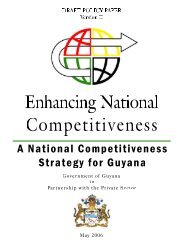Business Removing
Doing Business in 2005 -- Removing Obstacles to Growth
Doing Business in 2005 -- Removing Obstacles to Growth
- No tags were found...
You also want an ePaper? Increase the reach of your titles
YUMPU automatically turns print PDFs into web optimized ePapers that Google loves.
MEASURING WITH IMPACT 11<br />
How are the indicators constructed?<br />
The methodology for each of the topics in Doing <strong>Business</strong><br />
has 6 features:<br />
• The team, with academic advisers, collects and analyzes<br />
the laws and regulations in force.<br />
• This analysis yields a survey designed for local professionals<br />
experienced in their fields—such as incorporation<br />
lawyers and consultants for business entry, litigation<br />
lawyers and judges for contract enforcement,<br />
officials in land registries and real estate lawyers for registering<br />
property.<br />
• The survey utilizes a standardized business case to<br />
ensure comparability across countries and over time—<br />
with assumptions about the legal form of the business,<br />
its size, location and nature of operations.<br />
• The local experts have several rounds of interaction<br />
with the Doing <strong>Business</strong> team, typically 4.<br />
• The preliminary results are presented to both academics<br />
and practitioners for refinements in the survey<br />
and further rounds of data collection.<br />
• The data are subjected to numerous tests for robustness,<br />
which lead to subsequent revisions or expansions<br />
of the collected information. For example, the initial<br />
contract enforcement study collected and analyzed data<br />
for the recovery of a debt in the amount of 50% of income<br />
per capita, as well as for 2 other cases—the eviction<br />
of nonpaying tenants and the recovery of a smaller<br />
debt claim (5% of income per capita). After the release<br />
of Doing <strong>Business</strong> in 2004, it became clear that court and<br />
attorney fees were often too high to expect small debt<br />
cases to reach the court. As a result, the debt amount was<br />
increased fourfold in this year’s report.<br />
FIGURE 2.3<br />
Enforcing a contract in Poland—1,000 days<br />
Days<br />
1,000<br />
800<br />
600<br />
400<br />
200<br />
Filing of complaint 90 days<br />
0<br />
1<br />
Procedures<br />
41<br />
Source: Doing <strong>Business</strong> database.<br />
Trial and judgment<br />
730 days<br />
Enforcement 180 days<br />
The result is a set of indicators that is easy to verify<br />
and replicate. And extending the dataset to obtain other<br />
benchmarks is straightforward. For example, the Doing<br />
<strong>Business</strong> case studies assume a certain type of business—<br />
usually a domestic limited liability company. Analysts<br />
can follow the methodology, adjust the assumption and<br />
construct the same benchmarks for other standardized<br />
cases, for example sole proprietorships and foreign companies.<br />
The methodology for one project—enforcing a contract—illustrates<br />
the general approach. The indicators<br />
for contract enforcement are constructed by studying<br />
a standardized case of a payment dispute in the amount<br />
of 200% of income per capita in a country’s most populous<br />
city. The data track the procedures to recover the<br />
debt through the courts or through an administrative<br />
process, if such a process is available and preferred by<br />
creditors. The plaintiff has fully complied with the contract<br />
(and is thus 100% in the right) and files a lawsuit to<br />
recover the debt. The debtor attempts to delay and opposes<br />
the complaint. But the judge or administrator decides<br />
every motion for the plaintiff.<br />
The data come from readings of the codes of civil<br />
procedures and other court regulations, as well as from<br />
administering surveys to local litigation attorneys, with<br />
at least 2 lawyers participating in each country. In 30<br />
countries the surveys are also completed by judges to see<br />
whether their answers are similar to those of attorneys.<br />
They are. As with all of the Doing <strong>Business</strong> in 2005 topics,<br />
the data are for January 2004.<br />
Based on the survey responses, 3 indicators of the<br />
efficiency of commercial contract enforcement are developed:<br />
• The number of procedures, mandated by law or<br />
court regulation, that demand interaction between the<br />
parties or between them and the judge (administrator)<br />
or court officer.<br />
• The time of dispute resolution in calendar days,<br />
counted from the moment the plaintiff files the lawsuit<br />
in court until the moment of settlement or, when appropriate,<br />
payment. (This includes the days when actions<br />
take place and the waiting periods between actions.)<br />
• The official cost of court procedures, including<br />
court costs and attorney fees, where the use of attorneys<br />
is mandatory or common, or an administrative debt recovery<br />
procedure, expressed as a percentage of the debt.

















